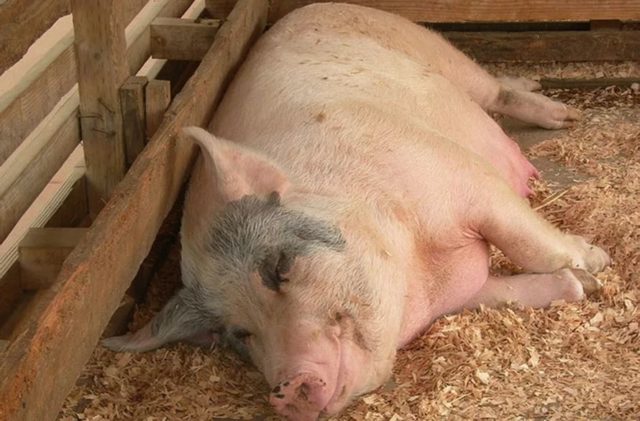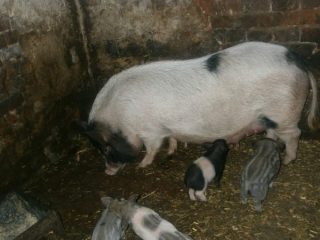Content
Artificial insemination of pigs involves the placement of a special device into the pig's vagina, which delivers the male's semen into the uterus. Before the procedure, the female pig is tested for heat.
Is it possible to artificially inseminate a pig?
Many farmers successfully use artificial insemination of pigs in practice to increase the productivity of animals and to obtain strong offspring from them. Problems often arise when pigs naturally mate. This is excluded with artificial insemination of sows.
The process of artificial insemination begins with the collection of sperm from the male. This is done using a cage and a built-in artificial vagina. After this, the extracted material is assessed macroscopically, followed by a microscopic characterization of the material. Only after these studies, boar semen is introduced into the prepared pig during the hunting period.
Advantages of artificial insemination of pigs
The method of artificial insemination of pigs is successful due to the ability to significantly shorten the fertilization period, since in one procedure a large number of females can be inseminated with the semen of one boar. If the material is of high quality, that is, from a breeding boar, then it can be used on several farms.
Advantages of artificial insemination:
- there is no need to take into account the mass of both individuals as in natural mating;
- the absence of direct contact between pigs avoids infectious diseases;
- This technique allows you to significantly reduce the required amount of sperm;
- it is possible to preserve a sperm bank for many years if the necessary conditions are met;
- the owner can be confident in the quality of the material;
- if fertilization is carried out simultaneously with a large number of females, then the offspring will appear at the same time, which will facilitate the care of newborn piglets.
In addition to these advantages, it is important to consider that young animals will be born with a certain set of characteristics.
Methods of insemination of pigs
Usually, two methods of artificial insemination of pigs are used: fractional and non-fractional. When using these methods, the biomaterial is diluted based on the calculation of about 50 million active sperm per 1 ml of sperm. But the volumes of diluted sperm used for fertilization are different.
To increase fertilization and produce healthy offspring, farms use the sperm of several boars that are not related to the dams. Mix sperm in any quantity after diluting the material from each individual. Before the procedure, the sperm is heated to a certain temperature and checked for sperm motility.
The fractional method of fertilizing pigs occurs in stages. In the first stage, diluted seed material is injected into the pig's uterus. The solution is prepared from glucose, sodium chloride and distilled water. At the second stage, upon repeated injection, there are no sperm in the solution. This is necessary to prepare the uterine microflora for fertilization.
The non-fractional method of artificial insemination involves the use of diluted sperm in the form of a concentrate. About 150 ml of concentrate is injected into the uterus through a catheter. In this case, you need to take into account the weight of the pig: per 1 kg of weight there should be about 1 ml of solution.
How to artificially inseminate pigs at home
Small farmers use a simplified scheme for inseminating pigs at home.
Young males are taken several times to mate with a female. Then they are accustomed to a toy in the form of a female. After developing the reflex, the animals mount the toy. Before collecting sperm, a mat is laid behind the doll to prevent slipping. An artificial vagina is attached to the doll. It should create pressure and slip. The hole is covered with a film with a rubber ring. After preparations, the male is released. The genital organ is directed into the hole, making massage movements, lightly pressing it.
After receiving the ejaculate, the female is secured in a clean pen. The procedure is carried out wearing sterile gloves. It is important to avoid infection in the pig's genitals, as this can result in the birth of dead or sick piglets. The pig's genitals are washed with warm water, treated with furatsilin and wiped dry with a towel. Stroking the female's sides increases oxytocin levels, which promotes fertilization.
When to inseminate
Artificially inseminating pigs is not difficult, but inexperienced farmers can make some mistakes. The most important thing is to determine the onset of heat in a pig in order to understand its readiness for insemination.
The first hunt in a pig begins at 5-7 months. Readiness for mating is repeated every 20-25 days.
You can determine if a pig is hunting by the following signs:
- restless, aggressive behavior towards other pigs;
- grunting, squealing;
- decreased, lack of appetite;
- swelling, redness of the genitals;
- mucous discharge from the genitals (the mucus should stretch well).
It must be borne in mind that the period of readiness for mating does not coincide with ovulation. One of the signs of ovulation is the immobility of the pig, which can last up to 2 days. This is considered the best moment for insemination.
Preparing pigs for fertilization
Boars are prepared for a year, since the male must be in healthy condition. This will ensure normal sexual activity of the animal. Breeding conditions can be achieved by eating a nutritious diet and spending a long time in the fresh air. By releasing a large amount of sperm, the male loses energy and nutrients. In emaciated or heavily fattened boars, sexual instincts weaken, activity decreases significantly, and the quality and quantity of sperm deteriorates.
Before the breeding period, the staff examines the male, adjusts the diet, and, if necessary, culls. The sperm is examined visually and then under a microscope.
Preparing females is a more labor-intensive process.Starts in a few weeks. Experts pay attention mainly to diet. The reproductive capacity of sows is also affected by:
- keeping sows;
- season;
- breeding male;
- piglet weaning time;
- heredity;
- general condition of the sow.
The correct diet for feeding pigs directly affects sexual activity, estrus, ovulation, and fertility.
Preparation of tools and materials
When inseminating a pig using a non-fractional method, you will need a glass flask or a plastic container with a lid with rubber tubes coming out of it. The catheter is attached to one tube, and a syringe is attached to the second. Through a tube with a syringe, the solution will be injected into a glass flask, and through a catheter it will pass to the cervix.
When carrying out the fractional method, you will need a special container with a heater, several flasks, and a probe (UZK-5). It consists of the following devices:
- catheter with tip;
- containers with 2 tubes;
- filter;
- clamps for blocking tubes.
After the probe is brought to the uterus, sperm is supplied through a tube, the second one is closed with a clamp. When the liquid has already been introduced, another tube is opened and diluent is supplied.
Carrying out the fertilization procedure
To inseminate a pig correctly, you need to prepare for the procedure. After all the necessary preparations (venue, female and her genitals, tools and materials), the procedure can be carried out. The device is first inserted straight, then it is raised slightly and inserted all the way. Next, attach the container with the seed, lift it up and introduce the contents. A glucose solution with salt is supplied through the second catheter.You can use one catheter by connecting different containers to it in turn. After insertion, leave for a few minutes, then carefully remove.
Material may leak from the female's genitals. In this case, the procedure is suspended for a few minutes, then the administration is continued. Involuntary contraction of the pig's vaginal muscles is also sometimes observed. It is necessary to wait until the female calms down and the spasms stop, then the procedure can be continued. To avoid spasms, the biomaterial is properly heated before injection.
The insemination procedure usually takes 5-10 minutes.
Maintenance of the sow after manipulation
No special care is required for the female after the artificial insemination procedure. The main thing is to leave her for a few hours to calm down and relax. Then you can feed. A day later, the fertilization procedure is usually repeated and a second portion of sperm is injected. If at a certain time (after 20-25 days) the female is not in heat, it means that fertilization has occurred.
Conclusion
Artificial insemination of pigs is a progressive method of producing healthy, strong offspring. It has advantages over natural fertilization. Popular in large farms and small farms due to its ease of use and time saving.
When carrying out the technique of artificial insemination of pigs, it is necessary to maintain hygiene, and then provide the fertilized sow with all conditions and a balanced diet.











